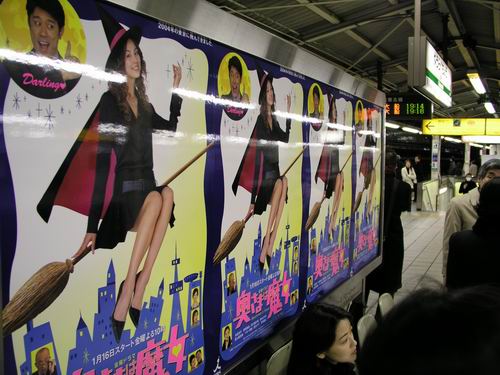
There
I was - standing on the platform at Yurakucho Station in early
January - and as I idly looked at the advertising billboard between a
set of fiberglass platform seats, my vision locked onto a poster of a
young woman riding a broom over Tokyo... "Bewitched in Tokyo"
it said (above photo). Not only the name, but the theme of the poster
tied in with
the 1960's American TV show "Bewitched". Growing interested
- not the least of the reasons being that the woman was quite
attractive (I, and most men I suppose, are absolutely helpless in the
onslaught of beauty rays that emanate from some woman...).
Looking over the poster (there were four identical ones in a row
actually) Inoticed a date and time... January 16th, at 12:00...
"Well-well-well, this is to be a new TV show here in Japan!"
I realized. A J-version of the show I so enjoyed watching as a kid
sitting in front of my parents old black and white tube TV (I'm
referring to the bank of 15 tubes inside the TV BTW).
Back at
home in front of my low-tech CRT monitor (always in front of one tube
or another), I went to the TBS site and had a look at their page for
the show. Wow... pages of history, fan letters - before it's even
aired the first show - thanks to the fact that a large number of
people in Japan, as in the US, watched the show as children.
Culture
Lesson #1
One reason so many US movies,
television shows, etc. are
popular here is because an overlapping part of the culture of current
Japan (as opposed to 17th century Japan) is the very same culture.
Why should J-watchers like the same shows as US-watchers? Why not?
It's their culture too!
January 16th, 2004 22:00
The
first episode got off to a rough start with low-budget computer
graphics, but once the actors took the stage it went pretty well. Is
that a breeze from the US 1960's I felt in the room?
Culture
Lesson #2
Much has been written about
"Japan's infatuation
with the West", but it has more to do with "benchmarking"
(PR-speak for "copy"). Let's face it - when you are in
the lead and are benchmarked, it's derisively called "copying",
but when you do it, it's suddenly called "benchmarking"!
"We benchmark and they copy". Anyway, "Bewitched in
Tokyo" is one result of all that benchmarking on this side of
the Pacific. Tokyo is a squeaky clean, steel & glass modern place
now, and it's time to enjoy life!
And... that's basically it.
In closing, allow me to comment on Japanese soaps (which is what it
really is here - with a three-month lease on life). In a
simplistic sense, you could say that US soaps depend on the audio
track for their success, and Japanese soaps depend on the visual
element. If you had to choose between only the sound or only the
picture, you would be better able to follow the story in many
US shows by listening to the sound only, and better able to
understand many Japanese shows the picture only. Or at least you
would be better entertained. Typically, if there is a scene of two
people having a discussion in a coffee shop (see Culture Lesson #3
below), the camera angle floats up in the air, peeks at them from
behind a stack of glasses on a counter, changes to half seeing them
from outside through the window which is reflecting people walking
by, etc. So, you might not understand the intricacies of the story,
but the show is entertaining to watch just for the cinematography
alone. Japan doesn't only make all those cameras, people here love to
use them!
Culture Lesson #3
Coffee shops. Simple to
explain. Tokyo is a vast city, so if you meet someone, chances
are you live an hour or more by train from where they live.
That, combined with the fact that most people's residences are on
the, um, "not overly spacious" side, creates a situation
where people generally meet each other at some agreed upon spot
in-between their two residences. Since public places where
people can actually sit down are few and far between (30,000,000
people in greater Tokyo), coffee shops fulfill this
function.
January 23rd, 2004 - that's
today as I write this
(What's that? It's July 27th, 2157 now for you the reader? Wow...),
and I'll be in front of the solid state - but still tube - TV this
evening for the second show.
Copyright
2004 by Lyle H Saxon,
Images Through Glass, Tokyo